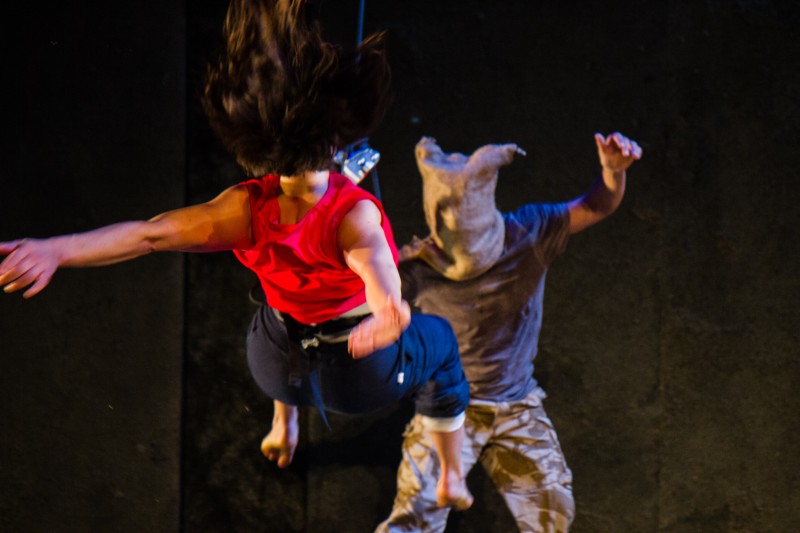 Aerial company Gravity & Levity present a show tackling current political events around the war with Afghanistan by drawing parallels with World War I. The emphasis on narrative and characterisation ritualises key moments in the lives of two soldiers: Private George Ellison and John Smith, who died in the First World War and the war in Afghanistan respectively. A montage in form, structure and medium, Rites of War weaves narratives, time and movement styles into complex scenes made possible by the versatility of Jonathan Campbell’s sophisticated aerial rigging and design. Artistic Director Lindsey Butcher’s aerial work forms a relationship between the stage area and a vertical stage behind. Floating between one and the other, performers act out a distorted narrative between the live of soldiers in 1914 and 2014.
Aerial company Gravity & Levity present a show tackling current political events around the war with Afghanistan by drawing parallels with World War I. The emphasis on narrative and characterisation ritualises key moments in the lives of two soldiers: Private George Ellison and John Smith, who died in the First World War and the war in Afghanistan respectively. A montage in form, structure and medium, Rites of War weaves narratives, time and movement styles into complex scenes made possible by the versatility of Jonathan Campbell’s sophisticated aerial rigging and design. Artistic Director Lindsey Butcher’s aerial work forms a relationship between the stage area and a vertical stage behind. Floating between one and the other, performers act out a distorted narrative between the live of soldiers in 1914 and 2014.
The piece is carefully structured to convey an overarching theme of dislocation and disorientation. Creating chaos out of order, one soldier’s scenes are played out in reverse. The pluralities of each scene on stage are visualised at the same time by digital scenes and figures appearing on the back wall and aerial performers inhabiting its vertical world. Characters also emerge, framed by a rectangular slit within it, that acts as a window into the everyday lives of the families. The insertion of documentary films with commentary from BBC Afghanistan correspondent David Loyn, and the date and title of each scene, prevented a busy and complex piece from becoming mayhem for the viewer. Constant stimulation and changing view-points provide the audience with plenty to unpick at any one time with feasts of emotive visual tableaus; successfully creating a world where multiple scenes and times can co-exist.
Striking and provocative moments are frequent but fleeting. For example Private George Ellison’s contorted posture wearing white undergarments conjures images reminiscent of Christ, pietas and the martyrdom of Jacques Louis David’s French revolutionary painting The Death of Joseph Bara. Power struggles and vulnerabilities are heightened by juxtaposing open and vulnerable characters with disguised and ominous ones; John Smith, carried and manipulated through an obstacle course of three figures in black with faces and eyes covered. Two dark, anonymous silhouettes, eyes and bodies disguised by Burkas, dance a bouncy ritual of every day chores or a dance of something more sinister.
Two aerial duets are performed side by side, transforming the wives of each soldier into their angels of death. In a dance of two halves, of two times, of two universes, the enormity of the events before the viewer is juxtaposed with the humanity of the soldiers. These duets really wanted to be magical and at moments they were. However their delicacy was undermined by an overly emotive soundtrack, frilly white costumes and an abundance of aerial vocabulary verging on spectacle that broke the captivating spell that had been cast. The recurrent theme of heroism in the everyday might have better been suggested by seeing the angels simply dressed as the soldiers’ wives to imbue these duets with more subtlety and vulnerability.
Darshan Singh Bhuller’s choreography draws on vocabulary from ballet, contemporary, breakdancing and characterisation from everyday movements and soldiers’ manoeuvres, making a strange mix of physical theatre and technical dance form. There are moments where this becomes clunky, the elevated leaps and jumping sequences lacked the grounded, weighted style of a soldier’s physicality. With an abundance of scenes, animations, films, and narratives, space for the choreography to be absorbed also often felt lacking.
The work as a whole is strong, thoughtful and technically sophisticated, however it is at risk of falling into the trap of many multi-disciplinary pieces: communicating the same thing in several different ways at the same time, over stimulating and undermining its message. Marking the centenary of the beginning of the First World War and the withdrawal of troops from Afghanistan, the show valiantly remembers and memorialises English soldiers, but as a result plays the topic a little safe.
